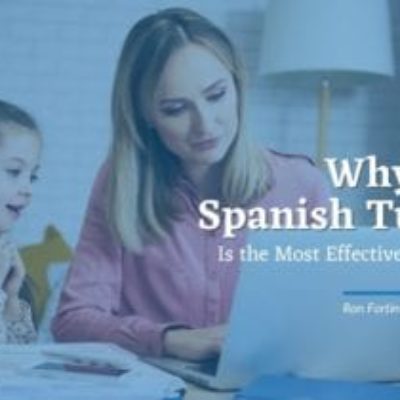
Your Child Speaks Some Spanish, Now What? A Roadmap from ‘Just Sentences’ to Real Fluency
If your child can already form basic Spanish sentences, you’re not at the beginning, you’re standing at the threshold of something really exciting.
This is the stage where so many homeschool families pause, unsure whether they’ve “done enough” or if it’s time to push forward. Here’s the good news: when students can string together sentences, they’re right on the edge of real progress. The momentum is already there. They just need a plan to carry them to the next level.
And at the end of this article, I’ll gift you a free printable “Spanish Fluency Ladder,” a visual roadmap to help you confidently guide your child from intermediate speaker to full fluency.
Let’s do this!
Join 559 million people on the planet who speak Spanish!
Sign up for your free trial Spanish class today. ➡️

Why This Stage Matters?
Many homeschool parents make the mistake of plateauing at this stage. Their teen knows basic vocabulary, can introduce themselves, order food, and maybe even describe their day in Spanish. But then… progress slows. Why?
It’s often because there’s no clear structure between “can speak a little” and “can speak fluently.”
According to a report by the American Council on the Teaching of Foreign Languages (ACTFL), only 20% of K–12 students in the U.S. are enrolled in foreign language courses, and most of those programs don’t last past a year or two. Homeschooling parents have the freedom to go deeper, but many simply don’t know what comes next.
Signs Your Child Is Ready to Level Up
If your teen can:
- Form complete sentences about everyday topics (e.g., their hobbies, family, or school day)
- Ask and answer simple questions
- Use present tense verbs correctly in context
- Recognize when they’ve made a mistake (even if they can’t always fix it)
Then congratulations—you’ve officially moved into the intermediate level, which is where the magic starts to happen.
From Sentences to Fluency: What Comes Next
Here’s a roadmap you can follow to build your child’s skills from sentence-level Spanish to genuine conversational fluency:
1. Strengthen the Foundation
Even intermediate students can benefit from revisiting the basics with more depth:
- Expand verb knowledge: Start with irregular verbs and introduce past and future tenses.
- Grow vocabulary with purpose: Focus on themed word sets (travel, health, school, tech).
- Encourage accuracy: Keep a “fix it” journal for grammar mistakes and corrections.
2. Add Structured Speaking Practice
This is key. Your teen needs real-time interaction, ideally with native speakers.
- Enroll in 1-on-1 classes that are customized to your child’s level.
- Use structured speaking prompts (we include these in our classes at Homeschool Spanish Academy).
- Have them narrate their day in Spanish, either aloud or in writing.
3. Introduce Immersive Content
Let Spanish become part of their environment:
- Watch age-appropriate YouTube channels or shows in Spanish.
- Listen to Spanish-language music or podcasts.
- Follow Spanish-speaking creators on social media for daily exposure.
4. Use Spanish in Real Life
The more relevant Spanish feels, the faster your child will improve.
- Cook a recipe using Spanish instructions
- Write letters to a Spanish-speaking pen pal
- Role-play conversations (restaurant, airport, job interview)
5. Set Milestones (and Celebrate Them!)
Tracking progress makes a big difference in motivation.
- Can they tell a story in the past tense?
- Can they debate a simple topic?
- Can they write a short essay?
Celebrate those wins. They’re signs of real fluency in the making.
What Fluency Actually Looks Like
Fluency isn’t just “sounding native.” It’s the ability to:
- Hold a conversation with ease
- Express opinions and feelings
- Understand native speakers in various contexts
- Adapt language use depending on the situation or audience
According to the Common European Framework of Reference for Languages (CEFR), fluency really begins around B2, where students can interact with native speakers without much strain and express themselves clearly on a wide range of topics. That level is absolutely attainable — and you can get there from here.
You Don’t Have to Map This Alone
Every learner is unique, but they all thrive with the right structure and guidance.
If you’re ready to take the guesswork out of “what comes next,” download our free PDF: “Spanish Fluency Ladder: What to Learn at Each Level.” It’s a visual guide that shows the skills, vocabulary themes, and grammar concepts to master at each stage of your child’s journey, from forming sentences to full-on fluency.
Download the Spanish Fluency Ladder Here
You’ve already helped your child get this far, and now, you’ve got the roadmap to keep going.
Do you want help bringing that roadmap to life? Our certified, native-speaking teachers at Homeschool Spanish Academy specialize in guiding homeschool teens through the intermediate stage and beyond, all in 1-on-1, flexible classes designed for real progress.
Let’s turn “I can say a few things” into “I can say anything.”

Join one of the 40,000 classes that we teach each month and you can experience results like these

“It’s great being able to interact with native speaking people and having a conversation with them not just doing all the work on paper. It’s also an amazing opportunity to speak with native Spanish-speaking people without having to travel to a native Spanish-speaking country.”
– Melanie

“Getting to know wonderful teachers who care about me and my growth in language and education. Evelyn Gomez and Erick Cacao are two of the most extraordinary people I have ever met, and talking with them in Spanish at the beginning of classes is always so fulfilling and greatly contributes to my happiness, joy, and wellbeing.”
– Abby

“I love that my children have the opportunity to speak with a live person. They get to practice Spanish in a 1-1 setting while improve their speaking, writing and reading skills during their lessons. HSA is a great way to learn Spanish for all ages! My children are 6, 9 and 11. My oldest two (9 and 11) have been taking classes with HSA for almost 2 years now. They love seeing their teacher each week. They understand the importance of learning several languages. I’ve seen them grow and learn with HSA. I’m excited to see how they will improve the more classes they take. I highly recommend them. You can’t bet learning and speaking with a live teacher. I’ve tried other programs. It’s just not as motivating.”
– Karie Ann, Parent of 3
Want more Spanish Homeshcooling resources? Check these out!
- Why 2-on-1 Spanish Classes Work Better for Beginners (Especially Middle Schoolers)
- How to Know If Your Child’s Spanish Program Is Working: 3 Signs of Real Progress
- Your Teen’s First 6 Months of Spanish: What to Expect and How to Support Them
- Equipping Your Child for Fluency: 8 Tips for Teaching Spanish
- Ways to Promote Internet Safety for Kids While Learning Online
- 7 Spanish Reading Games for Kids: Boosting Literacy Skills
- Spanish Curriculum Must-Haves: What Makes a Program Preschool-Friendly
- K-8 Spanish Success: The Natural Path to Bilingual Proficiency





